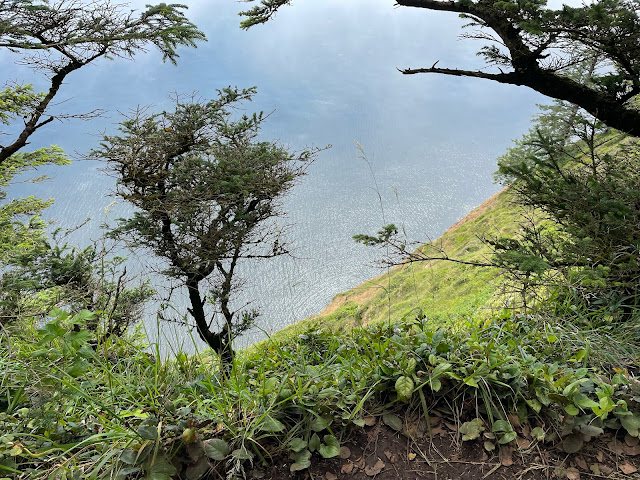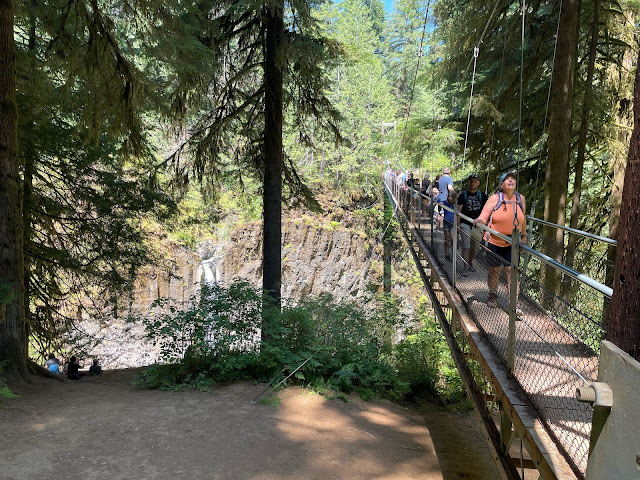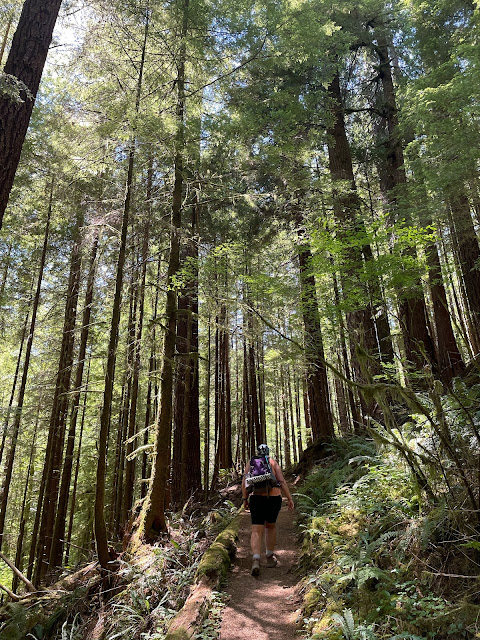As you drive up the Oregon Coast you encounter bay after bay that has been created by three shared elements. Firstly, A river running from the local mountains into the ocean. It carries sand and mud and trees and puts them all at the coast for use. The river spreads out at the coast where there is a short ledge before the depths of the ocean. Next a sand spit forms forcing the river to run parallel to the ocean for a mile or so. The water backs up behind this spit forming a tidal bay, usually with a challenging bar right at the entrance to the ocean. The river, of course, has come down from the mountains in a river valley, that it cut itself. But this valley often extends out into the ocean so there are these bookmark highlands at either end of the bay that jut out into the ocean. This mix, with different recipe amounts for the river, sand, and bluff are repeated as necessary down the length of the Oregon coast from the Columbia river to the Rogue.
Today as we are driving up the coast from Lincoln city we were looking for a little hike to go on just as we passed the Boy Scout (now Scout?) camp called Merriweather. This triggered a memory for me of hiking out on one of those highlands that sticks out into the ocean. This particular highland is especially Tall, Steep, Thin, and long. It is called Cape Lookout and it is a narrow finger of forested rock that sticks so far out into the ocean that it completely runs away from the bays that it defines. It is actually quite striking to look at it on a satellite shot, so I have tried to include one. (If you are accessing this blog from sometime in the distant future, like the year 2000, then I apologize, the map company probably went out of business. Wait, the map company and my blog company are the same company…). There is a 2.5 mile trail out to a viewpoint on the very tip of the cape and I thought that might be a nice easy 5 mile hike for us today.
The parking lot was pretty full when we pulled in. It is like 100 degrees in Portland this week and everyone who can escape to the coast has done so. Here we are only 50 miles west of Portland yet the weather is patchy fog with a temp in the 60s. Beautiful day for a hike. We have a lunch packed and plenty of water for this trip and think we are sort of going on a walk in the park. We are dissuaded from this a little by printed signs at the trailhead that warn of deep mud at the halfway point caused by ‘recent rain’. It hasn’t rained in Oregon in a month so we are a little suspicious that these are old signs. Though….. they don’t look all that weathered. We take advantage of the nicely maintained bathrooms, pit toilets but clean, and then down the trail we go.
This trailhead is the start of three different trails. The one that we will take goes straight ahead out to the end of the highland. Another goes left and steeply down the cliffs to end up on the beach below. The third goes to the right and also steeply down but to the north, ending up in the state campground at the beach on the other side of the headland. The start of the 3rd trail was taped off and had do not enter signs, though there was nothing that said ‘Trail Closed’.
The trail we are taking is a nice one track trail, smooth with pine needles and small stones. It enters immediately into a forest of predominantly Sitka Spruce, many of them towering giants. To the north a steep up to the top of the ridge. To the South, a steep down through towering trees to the white sand of a beach and the Pacific Ocean. I feel that I have to give more description than just ‘steep’. I mean, it is steep, almost shear, but it is also very high. We are something like 600 feet up on this headland and though we are not on a cliff at this moment, you can see ahead where we will be. The view at this moment is fantastic, we can see several miles to the next promontory south of us and down below there are below like ants on that beach way way down there.
About a half mile down the track you run into what may be one of the saddest and most ironic brass plaques I have seen. It is a memorial to a crew of a B17 that was flying along the coast during WWII doing their last training mission before being deployed overseas. They were supposed to fly to point desolation and were having trouble finding it due to the fog. The pilot took them down to essentially sea level to try and get below the fog but no joy. The started their ascent, and at around 900 feet, they hit Cape Lookout at 200 MPH. Though several people survived the crash, only one lived long enough be rescued by the party that took 36 hours to get their because they were in such a hard to reach location. The lone survivor clung to the cliff via a propeller imbedded in the mud and rock face. I call it ironic because I am guessing the last thing the co-pilot said was “Look Out !!”. I have a friend that told me you can do a hike from the local Scout camp at low tide and still see remains of the plane that have slid off the cliffs. I have also seen accounts of artifact hunters that have found parts of the wreck along the top of the hillside.
Ok, so I have this problem. Several accounts I have read of the crash insist that the plane hit the cape at an altitude of 900 feet. But when I look up a topo map of the area, the map insists that the cape is only around 350 feet high. So what gives? The topo was not using meters, I checked. Google Earth says that though the highest point of the cape is around 300M, the place where the plane crashed is more like 200M. So there you have it.
After a few nice views the trail jogs right into the small flat land that is the middle of the highland. The Sitka are huge and thick in this area. They are 5 to 10 feet in diameter and a 150 feet or more tall. Century old giants that have seemingly reached the max that is allowed by the violent storms that must rock this headland from decade to decade. Many of the biggest trees have either been blown down, their rootballs making a staircase obstacle to our trail, or they have been broken off 30 foot up making for these huge stumps in the forest.
 |
| Note Fern Balls in Trees |
The wind is blowing from the North and this has pushed the marine layer fog tight against the North wall of the cape such that cold wet fog is billowing up the cliff and into the trees. A steady but very light rain of big drops is falling, seemingly dripping of the branchs of the trees over our head. Perhaps this is the source of the ‘recent rain’ we were warned about.
The trail winds back and forth across the width of the cape. The length of the cape is 2 miles, but the trail length one way is 2.5 miles. This winding, some of it switchback hill climbing must account for that other half mile.
On either side of the cape, where you are up against the edge of the cliffs, it is rocky and dry. When you cross through the interior, in the flat area, there is often accumulated plant debris and standing water. In other words, it can be muddy. The misting effect from the North becomes more pronounced as we head out west on the trail and the rain becomes more pronounced. Still not enough to stop and put on a rain coat and still….. strangely local. My partner commented that this was strange weather and I replied that one would expect the weather to be the same 100 yards in any direction but it wasn’t.
The plant life was pretty much the standard PNW array, but with a stronger mix of Sallal and Deer Fern. The Deer Fern was especially lovely as this is the time of year it is ‘blooming’. The bloom on the Deer Fern comes in the way of fertile fronds that have black stems and smaller leaves. 4 or 5 of them extend up from the middle of the plant to a height of a foot or so. These are the parts of the plant that create spores and are seasonal. They will die back after awhile. The sterile fronds growing around the base of the plant are evergreen and will last for several years.
 |
| Deer Fern |
The trail crosses over to the North side of the cape right about at the 1.5 mile mark. Here is your only good view looking North. Well, I have been told that it is your only view looking North. Today what we have is a thick fog bank such that we can’t even see the beach which is presumably just down below us. So after staring at the blankness for a bit we turn around to see the trail going up and south right behind us. There too are more signs warning about the impending mud. This must be really world class mud to deserve all of these signs. There are a few people out hiking (as one might deduce from the full parking lot) and we have talked about the mud with a few of them. Some have gone all the way through and they don’t appear too muddy. I mean, the tops of their shoes are clean. Others are turning back at the signs. In all fairness, they have come over a mile and have had a nice hike and probably don’t need to get all muddy. Plus the kids didn’t want to leave the car and their electronics in the first place, COME ON DAD, LETS GO BACK.
My partner has a different take. Though she chides me for suggesting that this was an easy out and back of flatness, she is intrigued with the adventure that the mud warning seems to imply. What a Partner !!
We break our trekking poles and slug up the hill.
 |
| Danger Will Robinson !!! Mud !!! Danger !!! |
 |
| Tree Roots Of Death |
The issue turns out to be not so much one of mud, but of mud and water that has been captured by the large spreading roots of the Sitka. These roots form rounded foot size buckets that are distributed across the trail and which you have to slowly pick you way across. Well, if you are an agile youngster or have four legs you can probably make your way walking on the tops of the roots. If you slip off those shinny smooth, polished tops, however, you will go down a 10 inch hole, fall over and break your 65 year old leg bone. This would be non-ideal.
My partner and I have a mantra for this summer. This is our ‘No Major Injury Summer’. No doing something slightly silly and breaking an ankle or a wrist. No surgeries. No New Knees. We are going to go slowly and carefully through our adventures. Today, this means putting our feet into many of these roundish root puddles. We are both wearing waterproof hiking boots and so doing this isn’t too much of a problem except that you really can’t tell how deep the holes are. Most are like half an inch of mud. But a few are more like 6 inches of mud. The poles come in handy for testing this but I still hit a couple of deep places and got mud almost to the top of my boots. Everyone we met coming back said that there was still more mud ahead of us but that the slug was worth it for the payoff view.
I was noticing the people that we were passing. They were all ages though mainly over forty and fit. I think it would have been pretty easy for REI to set up a booth and film a commercial out here. Everyone was dressed like an advertisement for the Recreational Equipment Co-op. REI pants and REI sun shirts and carrying REI packs. I was comparing my new REI pack to some of the others I saw on the trail. Mine is nicer.
Slugging through the mud and root traps is much harder and slower than the level trail. It took us at least another hour to do the 1 mile out to the end of the cape. And more than half of that mile was mined with Sitka Root Mud mazes. I sure hope the pictures can do it justice. As you zig zag back and forth across the now narrowing tip, you have to run into the cliff on the South side and when you do you are rewarded with semi-clear views looking south. You at least have a clear view down down down to the ocean below. We run across a couple sitting on the bluff. They are looking at a Bald Eagle in a tree 100 feet below us. My partner gets a picture. The couple tell us they are also from Portland, escaping the heat of the city. They have nice REI packs. They also tell us that we are nearly to the end of the trail. We have heard that one before. However, they are not wrong.

This tip of the trail has a large open space of rock and dirt and a little well worn bench to sit on. There are a few other people out there, everyone is eating lunch. One guy is eating melon and throwing the rinds over the cliff saying, “Oh, the seagulls love these. I do it all of the time”. I really wanted to tell him to quit throwing his garbage onto the cliff or into the ocean. How should one handle a situation such as this? Should I ask him if he is a Republican? I figure if he is a Republican, then I need a gun in order to have a discussion. If he is a Democrat, then I can threaten to report him to REI. ESPECIALLY since he was bragging about how his COSTCO cargo pants were so much better than his REI cargo pants. It is all in the quality of the sweatshop where the clothing is made, you know. You need one that employs very young children because they have the small hands needed for intricate work and you only have to pay them in small balls of rice. Boy, I am a grouchy old man. I can’t wait to get home so I can sit out front and shake my fist and yell “You Kids Stay off of my Grass!”.
So. A quick lunch and then we head back for the car. Turns out that going back the other way is mostly uphill. Just a little. And uphil climbing through the muddy root traps is suprisingly easier than going slightly downhill. I think this is because you are effectively facing the ladder instead of not facing. (backing?).
That bald eagle is still sitting there in that tree way down there. Oh, and there is a flight of Pelicans!! I have never seen pelicans from so far above them before. Beautiful.
We make it through the mud with all due alacrity, only stopping to talk to people and tell them how much further the Mud extends. I insist they are halfway through but they insist that is what the last few groups of people told them.
When all is said and done, my Fitbit says I went nearly 6 miles. Is this because fitbit is wrong or is it because all of those little steps through the mud roots were bouncing me back and forth across the trail? I have this theory that FITBIT is telling you the perceived length instead of the actual length of your trek. Maybe it is the “as the geezer stumbles” as opposed to “as the crow flies”. Either way, I find that with a fitbit, I hike further. So I must be getting more exercise. I need a scale that auto-syncs with my fitbit so my fitbit can convince it not to read so high.






































































.JPG)
.JPG)
